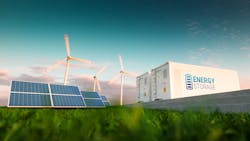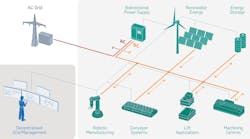DC for Industry Promises to Supercharge Benefits of Green Power
At a Glance:
- Industry is advancing towards converting internal plant energy networks from alternating current (AD) to direct current (DC)—DC for Industry—as a productivity amplifier to the accelerating green power revolution.
- Many industrial DC networking materials will cost less. DC cabling will have 40% less copper—needing only three conductors instead of five—and up to 25% less insulation.
- Exploiting DC for Industry will allow businesses to mitigate rising utility charges or shortages, as well as optimize internal power usage.
Each energy revolution through the ages—whether driven by water, steam, gas or electricity—has had momentous consequences for factory design and production technology, with great opportunities for those bold enough to seize them.
In A Great Leap Forward: 1930s Depression and U.S. Economic Growth, economist Alexander Field recounts how massive expansion of the electrical grid in the 1920s also was the catalyst for transforming how energy was distributed within factories during the interwar period. Mechanical distribution via metal shafts and leather belts—steam age technology that carried over to early electrification—was replaced by electrical wiring and small electric motors. That, in turn, changed how production was organized.
Today, industry is advancing towards another complementary transformation: converting internal plant energy networks from alternating current (AD) to direct current (DC)—DC for Industry—as a productivity amplifier to the accelerating green power revolution. The headline benefit of DC for Industry will be significant energy savings, but much more is possible: improved power supply stability and security, integration with high level production control systems, supply diversification and, of course, carbon footprint reduction. There will be opportunities for improving machine and process design.
Research projects are reimagining the factory power supply as a smart, open, scalable DC network. Their work includes identifying and testing DC topologies and infrastructure, hardware and software. Many existing components are industrial DC-ready or readily adaptable. Where new technology is required, as with power connectors, development is under way at Harting Technology Group and other companies. There will be market barriers like amortization cycles to overcome, but standardization is under way. So, think of Industrial DC as on-the-horizon change rather than over-the-horizon theory.
AC’s 20th Century Advantage, Challenged
Some might see this as vindication for Thomas Edison’s ill-fated championing of direct current in the late 19th Century. His low-voltage DC network couldn’t transmit efficiently over more than a mile. Early 20th Century utilities established grid dominance by leveraging AC’s comparable advantage: It can be stepped up to very high voltages, transmitted over long distances with little energy loss and stepped down progressively to voltages suitable for running machinery or household appliances.
Of course, DC never disappeared. It’s powering our smartphones, flatscreen TVs, LED lights and pretty much anything battery-powered. Plug-in adapters convert AC to low-voltage DC; we don’t give that a second thought. In industry, DC-powered devices like servo and stepper motors and brushless motors are preferred for many jobs. However, each time AC is converted to DC on a per-device basis, there is a small energy loss, usually 5-10%. Multiplied a hundred-fold or thousand-fold throughout a large plant or office building, that adds up.
A plant-wide DC grid where an external AC supply is converted just once, centrally, would eliminate such losses.
With greater ambition, more is possible. A smart DC network can be bidirectional. High-speed storage and a decentralized management system can optimize internal distribution, even recover and re-use waste energy, turning a factory into a microgrid. Feeds to specific applications can be more precisely tailored. Germany’s DC-Industrie multi-stakeholder research project was able to reduce the feed-in power from a local DC grid to an automotive robotic welding cell from 450 kw to 50 kw by the seamless integration of high-speed storage devices.
Recovered Power is Found Money
Waste energy recovery operates on essentially the same principle as regenerative braking on a car: Excess kinetic energy is captured when decelerating and stored for use when accelerating. Industrially, a bidirectional network can recuperate waste or braking energy from DC variable speed drives and other electrical systems. Recovered power can be stored and used as backup or peaking power or turned into a revenue stream. DC-Industrie estimates a reduction in AC-DC/DC-AC power converters in a factory plus the recovery of braking energy can yield energy savings in a range of 6-10%.
Centralized power management plus storage also can integrate multiple electricity sources like rooftop or carpark solar, de-peak operations and provide a steady, well-buffered current. It can protect against utility-caused fluctuations, blackouts, brownouts or other rationing calls. Any surplus power can be sold to the utility grid.
Each sector will find its own level of energy savings. In data centres, AC/DC conversion happens multiple times before power reaches servers. Estimates of energy loss range from 15-30%. Japanese telecom NTT claimed a 15% saving at a new data center by replacing converters at servers with more efficient centralized inverters. Among the improvements: a central DC feed generates less waste heat; servers require less cooling.
Many industrial DC networking materials will cost less. DC cabling will have 40% less copper—needing only three conductors instead of five—and up to 25% less insulation. Converters and other electronic devices connected to the grid will be smaller. Fewer on-board components like rectifiers, converters, line reactors, filters or brake resistors will enable designers to shrink some production equipment. High power electronics can be mounted closer to a motor, even integrated into it, shortening or dispensing entirely with expensive shielded motor cables.
Harting Proposals for Smart Connectors
Industrial DC feeds will need a different type of power connector. (Throughout Harting’s 76-year history, the company’s principal focus has been designing heavy duty industrial connectors.) The mains voltage can be slightly higher than the typical 400-600 V AC network—in a range of 650-800 V DC. With any power connector, sparking and arcing can occur if the unit is disconnected under load. With AC connectors, passive deterrents such as blocking plates or padlocks are usually sufficient to prevent disconnecting under load. The zero crossing of AC lessens but doesn’t entirely eliminate the danger.
The risk is greater with direct current, so DC connectors will require active locking, an embedded actuator for that purpose, says Norbert Gemmeke, managing director of Harting. “This can be by an autonomous interlock in the connector, or by the connector’s integration into the control system of the plant or system technology.
“We currently see two possible versions of a future DC interface. One contains contacts for both DC/AC supply plus Ethernet. In the second, contacts are provided for DC/AC power and signals, Ethernet and pneumatics as well as for linking the sensors/actuators to an external control system, either a PLC or a higher level cloud/IIoT system. Both solutions offer the required level of safety and protection.”
[2019-09_GettyImages-950739782-energy-storage]
Hybrid Sourcing Step Closer to Plant-wide DC
External green power sources like wind, solar and fuel cells are native DC producers. Their current is easily integrated into single DC factory network.
Hybrid power sourcing, mostly incorporating rooftop photovoltaic (PV) solar but with some on-site wind power, is becoming increasingly common. Globally, installation of rooftop solar by industry is outpacing the residential and commercial sectors. Embracing renewable power is socially responsible; ESG (Environmental, Social and Governance) sensitive investors value it.
Adopters of on-site generation cover a wide spectrum of industries: brewers and candy makers, big box and online retailers like Amazon.com and domestic and global logistics companies, tech giants like Apple and Samsung, automakers and appliance manufacturers. (Electricity for Harting’s new European Distribution Centre in Germany is supplied entirely by its rooftop PV array.)
Even with more widespread adoption of renewable power of all types, there remain legitimate questions about where all the electricity to decarbonize the planet will come from. Will it be there where and when it’s needed?
Exploiting DC for Industry to the fullest will allow businesses to play both defense or offense—defense, against rising utility charges or shortages, offense to optimize internal power usage to stay ahead of the competition. It may well open up possibilities yet to be identified.
As Alexander Fields notes in A Great Leap Forward, electrification of manufacturing sparked a redesign of factories. Instead of clustering machinery around central power sources like boilers in multi-story buildings, new plants realigned production horizontally, adopting more process-friendly and space-efficient single-story layouts.
DC for Industry, aligned with other megatrends like IIoT/big data, Industry 4.0, field-to-cloud deterministic Ethernet, artificial intelligence and more can drive fundamental change in how things are made. All are within reach.
Submitted by Harting Technology Group.


